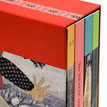| Brice Brown |
ANY INTERPRETATION
WILL DO |
Creeper dangles
against rock-face.
Pointed roofs bear witness.
The whole cast of characters is imaginary
now, but up ahead, in shadow, the past waits.
—from “Still Life with Strangers,”
Hotel Lautréamont by John Ashbery
John Ashbery divides his time between an apartment in Manhattan and a
house in rural New York. On the surface, this rather mundane biographical
detail does not appear exciting, or even particularly interesting––except
perhaps to the devoted Ashberian scholar or rabid fan attempting to log
the
very minutiae of the poet’s life in their journal. In fact, Ashbery’s
urbanrural
existence is rather well known, and his country house has even
been documented in various home-design magazines. But hiding within
this seemingly innocuous piece of information is the notion that
Ashbery might have structured his residences so they behave less like
dwellings in the more recognizable sense and more like two distinct,
yet
entirely co-dependent, creative laboratories. Or, to use a term coined
by
Ashbery’s partner, David Kermani, “created spaces.”
Ashbery has said he reads in one location and writes in the other. While
most likely an exaggeration, this statement nevertheless gets at the
true
umbilical nature of these two places. In a very concrete way, each residence
was carefully chosen by Ashbery to satisfy the specific requirements—both
logistical and nostalgic—needed to facilitate the various aspects of
his creative
output. As a result, his residences have evolved their own kind of
organic life, chock full of paintings and drawings, furniture, pottery,
glass,
toys and ephemera of all kinds.
The notion of an artist fabricating their environment in order to better
encourage the muse’s juices is not a new one. But the domestic concept
informing Ashbery’s two homes is a more complex and nuanced affair, and
is similar in scope to Balthus’ Chateau de Chassy, Frederick Church’s
Olana,
or Vanessa Bell and Duncan Grant’s Charleston Farmhouse. His homes are
as engaging and vital as the poems he writes. And of the two, his country
home is of particular interest, and can be viewed not only for its interesting
historical architecture, but as a vast well of inspiration for the production
of his poems, and even as one of his most fully realized works of art.
The house was designed by Michael O’Connor for the family of John
F. X. Brennen, and was built in 1894. Its architecture reflects the Colonial
Revival style, a type of hybrid mating earlier colonial elements with
contemporaneous
design flourishes. Ownership of the house passed down
through generations of the Brennen family, so that at the time Ashbery
purchased it in 1978, many of the period architectural details were still
in
very good condition. In a sense, Ashbery didn’t buy the house so much
as
inherit it and its history—and quite a few pieces of its furniture, too,
which are still in use throughout the house. He assumed a role similar
to
caretaker, and the care Ashbery has taken in maintaining the integrity
of
the gorgeous architectural bones and decorative details translates into
an
intimate, comforting interior. It is here where Ashbery maneuvers the
objects he has collected over the years—his “whole cast of characters”—
into excited vignettes, transmuting brick, mortar and wood into composition
and narrative.
Ashbery’s method of writing has been compared to the lowering of a
bucket into the constantly flowing river of words, images, associations
and
sounds inside his head; what this distended bucket captures forms the
grist
for his poems. An extension of this metaphor turns Ashbery’s country
house
into the river itself. The interiors are a domestic version of the endless
database flowing in his mind, producing a compilation of stimulation
and
memory. Regarding his poetry, Ashbery once stated that there is no subject
—
BRICE BROWN exhibits his paintings at Francis M. Naumann Fine Art, New
York, where he will have a one-person show in September 2008. His exhibition
Selling The Sound Of My Voice, done in collaboration with composer
Alan Shockley,
was held at vertexList gallery in Brooklyn, New York, in the Fall of
2007. As
a writer and art critic, he is a regular contributor to The
New York Sun. He has also
written numerous essays for exhibition catalogues. For more info go to
www.bricebrown.com.
For the complete article purchase The
Sienese Shredder #2
Related article in the Sienese Shredder #1
John Ashbery - Postcard Collages
Also by Brice Brown
Dead Reckoning
Back to The Sienese Shredder #2
| 

